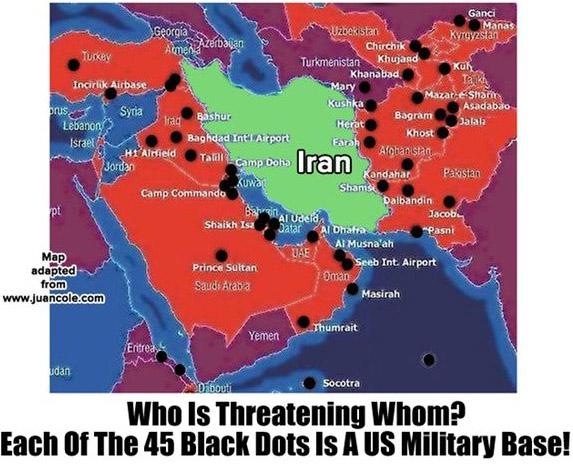Iran's Deep Distrust Of America Is Rooted In History

Iran Has Little Reason To Trust America
While officials claimed the agreement would halt much of Iran’s nuclear program and ratchet back other elements, several U.S. senators, both Democrat and Republican, voiced displeasure with the agreement. They argued that the U.S. and its partners offered too much for something short of a full freeze on uranium enrichment. Also, if part of the boatload of money released at the signing of the agreement was used to fund Iran’s many proxy wars it would create chaos. If Iran does not halt and reverse its course it can always ramp up its plans to develop a nuclear bomb at off-site locations.
Much of the problem America has with Iran stems from the perception that we have created over the years by portraying Iran as a larger than life boogeyman that threatens our very way of life and existence. Iran was elevated to this level when President George W. Bush included Iran as a member of the "Axis Of Evil" in his State of the Union Address in 2002. Unfortunately, Washington and the politicians who reside there often mislead us as they allow agendas of special interest to influence policy. When it comes to Iran’s official stance towards America anyone saying that Iran has good reason not to trust the American government is making an understatement. America through its foreign policy has wreaked havoc upon many countries few have been affected or suffered from our meddling as much as Iran.
A somewhat neutral source for information on the history of Iran post-World War II is Wikipedia. It shows America has constantly interfered in their internal politics. In 1953 the British M16 and the American CIA organized a military coup d’etat to oust the nationalist and democratically elected Prime Minister and put in power Mohammad-Reza Shah Pahlavi, the man we all know as the Shah of Iran, in Persian Shah means king. It is only fair to call attention to some very damning declassified documents released recently, the approximately 1,000 pages of documents, shed light on the Central Intelligence Agency’s central role in the 1953 coup that brought down Iranian Prime Minister Muhammad Mossadegh.
The documents conflict with the U.S government’s long denied involvement in the coup. The State Department first released coup-related documents in 1989 but edited out any reference to CIA involvement. Public outrage coaxed a government promise to release a more complete edition, and some material came out in 2013. Two years later, the full installment of declassified material was scheduled but the release was delayed fearing it might interfere with the Iran nuclear talks that were taking place. Now they have finally been released, it should be noted they are not complete because numerous original CIA telegrams from that period are known to have disappeared or were destroyed long ago.
What is clear and finally brought to light is the CIA plot known as Operation Ajax, was about oil. In early 1951, amid great popular acclaim, Mossadegh nationalized Iran’s oil industry. A fuming Great Britain began conspiring with U.S. intelligence services to overthrow Mossadegh and restore the monarchy under the Shah. While some of the U.S. State Department, the newly-released cables attempt to blame the British for the tensions and indicate efforts to work with Mossadegh plans were made for a coup. The coup attempt began on August 15th but was swiftly thwarted. Mossadegh made dozens of arrests. General Fazlollah Zahedi, a top conspirator, went into hiding, and the Shah fled Iran. At that point according to a newly declassified cable sent on August 18, 1953, the CIA under the impression the coup had failed decided to end their role. The message read, “Operations against Mossadegh should be discontinued.”
Washington wanted to make sure nothing "could be traced back to the U.S,” however, this cable was ignored by Kermit Roosevelt, the top CIA officer in Iran. What unfolded next is pivotal, on August 19, 1953, with the aid of “rented” crowds widely believed to have been arranged with CIA assistance, the coup succeeded and Iran’s nationalist hero jailed and the Western-friendly Shah placed in power. The existence and extent of Operation Ajax have long been a major point of contention for many Iranians from which the flames of anti-Western sentiment grew fueling a surge of nationalism. In 1979 this culminated in the U.S. hostage crisis, the Shah being overthrown and the creation of the Islamic Republic.
During his time in power, the Shah maintained a close relationship with America and shared our views towards the Soviet Union its northern neighbor. Iran was a strong ally in efforts to keep the Russians contained during the cold war. While the Shah westernized and modernized Iran arbitrary arrests and torture by the Shah’s secret police were used to crush all forms of political opposition. Ayatollah Ruhollah Khomeini an active critic of the Shah publicly denounced the government and was arrested and imprisoned for 18 months. After his release when Khomeini publicly criticized the United States government he was sent into exile. When oil prices spiked in 1973 due to an oil embargo declared by OPEC and several other countries a flood of foreign currency into Iran caused double-digit inflation;
Social unrest from waste, corruption and a recession resulted in protests and strikes that spread until they reached a point where the Shah fled the country. Ayatollah Khomeini returned in 1979 and formed a new government. Over the next several years uprisings were violently subdued as the new government went about purging itself of the non-Islamist political opposition that had joined with them to overthrow the Shah. Tens of thousands of Iranians were executed by the Islamic regime.
The hostages were finally set free but many Americans continue to view this as a slap in the face.

